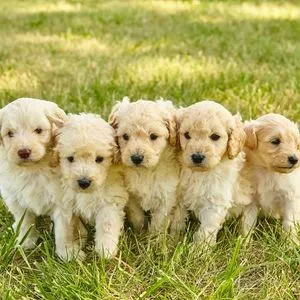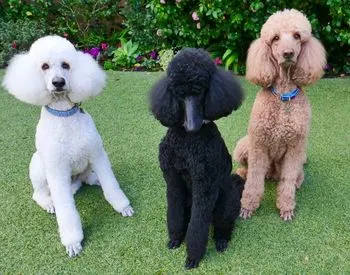More than thirty years after the first Goldendoodles were bred, it’s still a family favorite. This is not a surprise to anyone who has spent some time with this poodle crossbreed.
Part poodle and part Golden Retriever, the Goldendoodle has shown itself as a wonderful combination of the two breeds.
Over the years, the two breeds have meddled into a new breed that takes the best parts of each. Creating a dog that works well in many different situations.
Loved by families for their gentle playfulness and fondness of children. They also make great therapy and service dogs. As a combination of two intelligent breeds, they are easy to train and want to please.
Due to their low shed nature they appeal to people like myself who love dogs but are allergic to many of them. As a friend to all, they work equally well with couples or singles. Plus, they are happy to go wherever you go.
A lot has changed since the first Goldendoodles were bred. With each passing year new changes come about as the breed continues to evolve and be refined. Most of it is good, but some of it’s less so.
Join us as we discuss this wonderful dog and what you should know about them. Both the good and the bad.

Goldendoodle Overview
For those of you that just want some basic information about the Goldendoodle, here is a quick facts list.
Quick Facts About the Goldendoodle in 2024
| Breeding Mix: | Part Golden Retriever and Poodle, maybe more depending on type of Goldendoodle |
| Sizes: | Teacup or petite, mini, medium and standard |
| Height | 8 and 23 inches tall at shoulder |
| Weight | 7 to 120 pounds |
| Lifespan | 12 and 15 years |
| Traits | Social, outgoing, playful and intelligent |
| Colors | Cream, apricot, red, black, chocolate (dark brown), silver and gray coloring with various patterns like Parti, Phantom, Tuxedo or Merle. |
| Training | Easy to train with proper guidance |
| Maintenance | High maintenance requirements. Goldendoodle need regular grooming |
Goldendoodle Basics – What’s the same and what has changed
Goldendoodles and Labradoodles stand out from the rest of the doodle world. This is due to breeders coming together to create standards for these pups. Thus, elevating them to a higher level than just a designer breed where two purebreds are mated.

1. Breeding
While most Goldendoodles are still a cross between a poodle and a Goldendoodle, many quality breeders have moved beyond the first- or second-generation breeding. With many of the Goldendoodle that are available today classified as multigeneration.
With multigeneration doodles, breeders place more emphasis on the desired outcomes, like good temperaments, wavy coats and low shedding, rather than the just the mix. This results in a more predictable outcome then when mating to different types of purebreds.
Though, more time is still needed before they will be truly consistent in their looks and temperament like with purebreds.
Generation Classifications
Goldendoodle Generation classifications are just a way to indicate how they were bred. As I mentioned above, Goldendoodle generations are slowing going away, but there are still many breeders that use them.
Here is a quick overview of what they mean.
- A F1 Goldendoodle is 50% Poodle and 50% Golden Retriever.
- If you mate a F1 Goldendoodle with a poodle you get an F1B Goldendoodle. This would give you a dog that is approximately 75% poodle and 25% Golden.
- Or you can mate an F1 Goldendoodle to a Golden Retriever. This combination is still called an F1B, but its genetic makeup should have more Golden genes than poodle genes. Generally, this means more shedding but less maintenance.
- If you mate two F1B Goldendoodles they called a multigen doodle.
Check out the chart below to see a visual representation of the Doodle generation classifications.
The percentage of breeds indicated above is just an estimate. Nature does what it wants. There are no guarantee which genes are handed down to the off-spring. Only that each parent contributes half the genes.

Breed Standard
What’s new in the world of Goldendoodle is that they now have a breed standard that was developed at the Goldendoodle Association of North America (GAMA) a few years back.
The Breed Standard covers the four available Goldendoodle sizes including; the Petite, Miniature, Medium and Standard. It also includes recommended standards for size, looks, and temperament.
This last standard is not included in most AKC Breed Standards for conformation show breeds.
GANA also created an awards program that distinguishes members that adheres to certain health testing requirements. We will talk about this more in the where to get a Goldendoodle section.
2. Types of Goldendoodles
You may not be aware of this, but there are three types of Golden Retriever/Poodle Mix breeds; the English, the American and the Australian Goldendoodle.
The differences affect their build, colors and maybe even health.

English Goldendoodle
The English Goldendoodle is a mix between the English Golden Retriever which tends to be cream in color and a white or cream-colored Poodle. This results in a cream or white colored Goldendoodle.
In addition to a lighter color, English Golden Retrievers are bred to be a little shorter and stockier than the American Golden. Their fur is also shorter with more of a wave to it.
The English Golden Retriever is often portrayed as being healthier than the American Golden Retriever.
While both Goldens are susceptible to the same health conditions, the European bred Golden does have a lower rate of cancer. Though compared to other breeds, the rate of cancer in European Golden Retrievers is higher.
It’s important to note that the English, American and Canadian Golden Retrievers all originated from the same Scottish bloodline. The differences in look and size was caused by different breeding practices across the Atlantic.
American Goldendoodle
The American Goldendoodle is a mix between the American Golden Retriever which tends to be red or an apricot color and any colored Poodle.
Although American Goldendoodles tend to be a shade of red they can also be cream, apricot or any color the poodle comes in. You can even find a black Goldendoodle.
Australian Goldendoodle
The Australian Goldendoodle is very different from the English and American Goldendoodles.
Instead of crossing a Golden Retriever with a Poodle, Australian Goldendoodles are a mix between an English Goldendoodle and an Australian Labradoodle.
While the English Goldendoodle is a mix between just a Golden and Poodle, the Australian Labradoodle can have up to seven different breeds mixed in. Thus, changing the genetic makeup of the dogs.
Plus, which other breeds were added can vary from one Australian Labradoodle to another.
Trying to decide between a Goldendoodle or a Labradoodle? We compare the two crossbreeds in our post Goldendoodle vs Labradoodle: Which is Better?

3. Goldendoodle Sizes
Goldendoodles come in four size ranges: the petite goldendoodle, mini goldendoodle, medium goldendoodle and the standard goldendoodle.
The size of the doodle is generally dictated by the size of the poodle. Hence a standard Goldendoodle is breed using a standard poodle. A mini poodle is used for a mini doodle. For medium sized doodles a breeder may choose to use a Moyen poodle or a larger mini poodle. Petite doodles are typical bred using a toy poodle and a small mini doodle.
When mixing different sized breeds, you can end up with a wide range of sizes in the offspring. This is especially true with the Goldendoodle.
How big is a full-grown Goldendoodle?
What size your full-grown goldendoodle will become depends on a number of factors including the size of the parents, grandparents and even great grandparents.
It is not uncommon for a standard F1 Goldendoodle to be larger than its parents. I have seen Goldendoodles that are well over 100 pounds even though neither the Standard Poodle or Goldendoodle are that large.
Same thing goes for the smaller Goldendoodles. Pairing a Golden with a mini poodle does not always make a mini sized Goldendoodle. Sometimes they can end up in the medium sized range and other times they can end up out of portion.
An example would be a doodle with short legs and a long body. I am sure we have all seen these types of doodles.
When choosing a mini or petite Goldendoodle, pick your breeder carefully. It is best to get a multigeneration doodle when you want a smaller sized dog.
This allows the breeder to reduce the size of the dog in a slow and careful manor. Pairing a full sized Golden with a toy poodle can cause some undesirable outcomes.
GANA Goldendoodle Size Chart
| Size Range | Height Range | Typical Weight Range |
| Petite | Below 14 inches | 25 lbs. or less |
| Miniature | Over 14 but under 17 inches at wither | 26-35 lbs. |
| Medium | Over 17 but under 21 inches at wither | 36-50 lbs. |
| Standard | Over 21 inches at wither | 51 or more lbs. |

4. Goldendoodles Temperament
Regardless of which type of Goldendoodle you choose, they all have friendly, outgoing temperaments. But you may find some differences between the different sizes of Goldendoodles.
If properly socialized the standard and medium sized Goldendoodles will be confident, friendly dogs that love to spend time with their families. Especially with kids who are willing to play with them.
They will love to be outdoors running around, playing fetch and in most cases going for a swim. After all, both the Poodle and Golden were breed to retrieve in water.
The smaller Goldendoodles may be more active than their larger counterparts. They may also have more fear related issues due to their small size. But they can be just as friendly, as long as they have been properly socialized.
All sizes are smart and easily trainable. If this is your first puppy consider taking training classes with your dog to learn how to train them.
The down side of these very social dogs is that they don’t like being alone. Leaving your pup alone for long periods of time can lead to separation anxiety. These dogs are best with families who are around part of the day and people who work from home.
Boredom is another issue with these pups. Boredom can lead to some undesirable actions as they try to entertain themselves. This includes destructive chewing and barking. Daily exercise, multiple times a day, will help to keep boredom at bay.

5. Goldendoodle Trainability
The Goldendoodle is easy to train with the right motivation. Goldendoodles are intelligent, social dogs that want your approval and enjoy treats as rewards. As long as you are consistent with your commands, and train often, your Goldendoodle will quickly pickup on want you want them to do. This includes potty training your doodle.
They do not like to be scolded though. Using negative reinforcement with your Goldendoodle will most likely backfire. It will just result in a dog that is scared of people. Dogs that are scared of people are more likely to bite.
If this is your first puppy consider taking training classes with your dog to learn the right way to train them.

6. Allergies and Shedding
One of the things that brought doodles to the public’s attention was the claim that poodle mix breeds are hypoallergenic and don’t shed.
The belief was that since the Poodle doesn’t shed much, neither would a poodle mix-breed. For the most part this can be true, but not always.
First generation poodle mix breed will generally shed less than a purebred Golden. But once you get passed the F1 generation it becomes harder to predict if a doodle will shed or not, simply because you don’t know which genes are passed down.
But in recent years, the genes that contribute to shedding have been identified allowing breeders to a make educated guess on which pairings will result in low-shedding dogs. So, if you choose a breeder that does this kind of testing you will have a good chance of getting a low-shedding dog. But nothing is guaranteed.
So, what about pet allergies?
Pet allergies are believed to be caused by proteins that are found in a dog’s skin cells, saliva or urine. Most dog allergies are triggered by exposure to dander when a dog sheds. Dog dander is a small piece of skin that’s attached to the end of each hair.
Since Goldendoodles can be bred to shed less, there is less exposure to the proteins.
However, there are other ways that people can come in contact with the protein. Some of these are; being licked by a dog, petting them, brushing them or cleaning up after one.
The best way to know if you will be allergic to the dog is to spend time with them or the parents. Though this may be hard to do.

7. Goldendoodles Colors
Goldendoodle colors is another area that things have changed for the Goldendoodles in the last few years.
Previously, Goldendoodles came in an assortment of solid colors since they could inherit any of the coat colors of either the Golden or Poodle.
| Golden Retriever Coat Colors | Poodle Coat Colors |
| Cream | Cream |
| Apricot | Apricot |
| Reds | Red |
| Black | |
| Chocolate (dark brown) | |
| Silver | |
| Gray |
They can also inherit the various color patterns that are common in poodles which are Parti, Phantom, Tuxedo. Plus, poodles can carry the fading gene that can turn their black coats to gray or dark brown coats to a lighter brown.
But now you can also find Goldendoodles in Merle patterns, also called a dapple coat. See the description below from the American Kennel Club about merle coats.
Merle is characterized by irregular blotches of fur set on a lighter background of the same pigment, such as solid black on gray (called blue merle) or solid brown on tan (red merle). Blue and partially blue eyes are often seen with the merle pattern, as well.
American Kennel Club
Although beautiful and unique, this color can also be associated with health problems, primarily deafness and blindness.
As the AKC pointed out, there are health risks associated with the Merle gene. When a dog inherits two merle genes, the puppies can be born deaf and/or blind as stated about. They can also be born with physical defects.
The merle gene is not associated with either the poodle or Golden, which means another breed has to be brought into the mix to create the merle affect.

8. Goldendoodle Maintenance
Goldendoodles are high maintenance dogs. If anyone tells you otherwise they are either not properly caring for their dog or they are lying.
All doodles that inherit the poodles curly coat will need to be groomed every six to eight weeks. Depending on the size of your dog, where you live and the condition of the coat, professional grooming can cost between $50 for a small doodle up to $200 for a standard sized doodle.
The only exception are Goldendoodles that inherit the Golden’s straight double coat. But, then you will be spending your time cleaning up dog hair from everywhere.
In addition to frequent haircuts your doodle will need to be brushed every few days to keep the mating at bay. Of course, all this grooming also means that they will have even less hair to shed.
You can choose to groom your doodle yourself. That is what we do. The cost to buy the required grooming equipment is between $200 to $1000. With doodle haircuts for a large dog costing over $100 in some areas, you will recoup the money in no time.
There are even DIY Doodle Grooming Facebook groups that can help you get started.

9. Goldendoodle Exercise Requirements
Goldendoodles are active dogs, therefore they are happiest when they are moving. Exercise can be in the form of daily walks twice a day and fun games of fetch or tug of war a couple times a day.
They do best in active homes where someone is around throughout the day. Goldendoodles that do not get enough exercise or are left alone for long periods of time can become destructive or bark excessively.
Of course, all dogs are different and have different exercise needs. If your dog starts to get into trouble they probably need more exercise.
10. Goldendoodle Health
Goldendoodles are an overall healthy breed but they can develop health conditions that are common to both the Golden Retriever and Poodle.
Health concerns include:
- Ear Infections – This is due to their long hairy ears that can reduce air flow and increase moisture that can cause infections
- Sebaceous adenitis – Skin disease
- Hip dysplasia – This is a condition in which the thigh bone becomes displaced from the hip joint. There is a strong genetic component with this condition, which can be avoided through genetic testing
- Subvalvular Aortic Stenosis – A disease which causes a narrowing at the aortic valve of the heart
- Addison’s disease – Also known as hypoadrenocorticism, this disease decreases hormone production from the outer part or cortex of the adrenal gland
- Various eye diseases – Common eye diseases include progressive retinal atrophy, cataracts and glaucoma
- Von Willebrand’s disease – a blood condition that affects clotting
- Gastric dilatation-volvulus (GDV) also known as Bloat – this is a common condition in both the poodle and Golden Retriever. GDV occurs when a dog’s stomach fills with gas, food, or fluid and subsequently twists
To minimize the risk of getting a dog with health issues, ask the breeder for proof of health testing on both the parents.
Possible Health Testing includes:
- Hip certifications from the Orthopedic Foundation for Animals,
- OFA heart clearance
- Certification from the Canine Eye Registry Foundation that the eyes are healthy
- An OFA elbow clearance for standard Goldendoodles,
- An OFA knee clearance for small or medium-size Goldendoodles
- A DNA test for progressive retinal atrophy
For more information, see the Ribbon Requirements set by the Goldendoodle Association of North America.

11. Goldendoodle Lifespan
The average Goldendoodle’s lifespan is between 11 and 15 years. But small Goldendoodles can live longer.
12. Goldendoodle Costs
Goldendoodles are expensive dogs. The cost to purchase a Goldendoodle ranges between $800 up to $15,000. Depending on where you get them from and if they are trained.
At $800 up to $2,000 your puppy may be coming from a puppy mill. Since puppy mill dogs are kept in horrible conditions and not treated humanely you want to stay away from them.
Puppy mill puppies are often sold at puppy stores or online puppy brokerage sites. If they have a lot of dogs to sell they are most likely a puppy mill.
The price of a genetic health tested puppy is between $3,500 and $5,000. Older puppies that come already housebroken and trained can cost $8,000 and up.

13. Where to Get a Goldendoodle
There are a few ways you can get a Goldendoodle.
1. Breeder
Going to a local breeder is the most common way of getting a Goldendoodle puppy. Make sure to buy from a goldendoodle breeder that does health testing. The Goldendoodle Association of North America offers an award program that indicates the level of health testing done by a breeder.
A Red Ribbon award shows that the breeder performs the basic health tests required under GANA guidelines. A Blue Ribbon is awarded to breeders who go the extra mile to perform additional recommended tests as outlined in GANA guidelines.
2. Rescue Groups
Another option is to look for an organization that specializes in Goldendoodle Rescues. Many of these groups are national with volunteers in all states.
3. Guardian Home Program
You can also look for a breeder that offers a Guardian Home Program near you. With Guardian Home Programs you keep the dog but the breeder maintains the breeding rights of the dog. You have to agree to breed the dog for a specified number of times or years. Once you fulfill the contract obligations the dog is fixed.
For more detailed information on where to get a Goldendoodle, visit our post Best Places To Find a Goldendoodle Puppy.

Pros and Cons of the Goldendoodle
The positive qualities of the Goldendoodle is that they are a friendly, intelligent, and playful companion that are easy to train, relatively health and does not shed much. The negative qualities of the Goldendoodle is that they are expensive to buy and own, are high maintenance, require a lot of social interaction and can experience separation anxiety.
Is the Goldendoodle the right dog for you? Join us to find out why the Goldendoodle is not for everyone.
Bringing Home, a Goldendoodle Puppy
Once you decide you want a Mini Goldendoodle, you should start thinking about what you need for when you bring your puppy home. Puppies require many things, like a leash and collar, food bowls and toys.
One of the things you might not think about is where your puppy will go to the bathroom. Having an established place to train your puppy to go outside will make potty training easier. To learn more, check out our posts on Potty Training a Puppy: Made Easy and Outdoor Dog Potty Area Guide.
